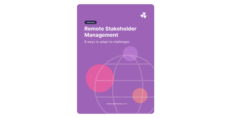Stakeholder Plan Foundations: How to Get Started

Creating your first stakeholder plan? Or looking for a quick refresher or some tips to make your next plan a little bit easier (and more effective)?
Explore the foundations you need for successful stakeholder planning, along with clear steps you can follow for creating your stakeholder plan.
What is a Stakeholder Plan?
A stakeholder plan is a written document that covers your stakeholder management (or engagement) goals and strategies. Types of stakeholder plans (and other terms used to refer to the plan) include:
- Stakeholder management plans
- Stakeholder relationship management plans
- Stakeholder engagement plans
- Public participation plans
- Community engagement plans
- Stakeholder communication plans
This document will outline who your stakeholders are, why you’re engaging with them, any issues you need to manage, how you’ll manage them, and who is responsible for what.
Stakeholder plans are usually created by the project manager or stakeholder professional, in conjunction with others who are involved in the project or organization.
Why Create One?
The purpose of a stakeholder plan is to take a more considered and strategic approach to stakeholder management or engagement. In turn, managing and engaging with stakeholders more effectively should lead to a positive impact on the project or organization.
More specifically, creating a stakeholder plan can help you:
- Define your goals and what success looks like
- Identify key stakeholders, issues, interests, and expectations
- Anticipate stakeholder needs and manage concerns more proactively
- Identify suitable communication methods, platforms, and frequency
- Understand the potential impact of stakeholder management or engagement
- Define the scope of the engagement and any limitations
- Assign resources (budget and staff time) for managing stakeholders
- Prioritize limited resources to maximize effectiveness
- Assign roles and responsibilities for required actions
- Get your team (or internal stakeholders) on the same page with your approach
- Report on activities and measure success
Stakeholder Plan Foundations
Before you can write your stakeholder plan, you’ll need to do some pre-work. These foundations will give you the insights you need for effective stakeholder planning:
- Stakeholder identification – Who are your stakeholders? List out any groups or individuals that might have an impact on your project or be impacted by the work.
- Stakeholder analysis – Analyze stakeholders based on impact, influence, interest, expectations, sentiment, concerns, and other characteristics.
- Stakeholder mapping – Use your stakeholder analysis to visualize stakeholders (and their characteristics) on a matrix so you can identify themes, group together different stakeholders, and determine the approach you’ll need to take with each group.
Don’t be tempted to skip ahead — knowing your stakeholders is critical to choosing the right strategies and priorities.
One-Page Stakeholder Plans vs Traditional Plans
Ever created or read through a traditional 30+ page stakeholder plan?
If you have, you’ll know that they’re time-consuming, unlikely to get read in full, and tend to end up on the shelf — unused with a fast-approaching expiry date.
The best stakeholder plans are ones that get read (in full), implemented, and kept up-to-date. That’s why we always recommend a one-page stakeholder plan. They’re focused, quick to develop (and adapt), and more likely to be read, adopted, and actioned.
Want to learn more? We go into more detail inside our Guide to Creating a Stakeholder Management Plan.
3 Steps to Create Your (Super Practical) Stakeholder Plan
Here’s how you can create your own one-page stakeholder plan:
Step 1: Think Long-Term

The first step in the process is to create a high-level plan for the project duration (or a 3-year timeframe) that outlines:
- Your current situation
- 1-3 long-term goals (e.g. 3-years)
- Short and medium-term goals (e.g. 2 years, 1 years, and 6 months)
- Strategies needed to deliver each outcome
- Operations needed to support the strategies
This isn’t your final plan, but an important step to ensure your plan aligns with your long-term vision.
Step 2: Break It Down

The next thing you need to do is convert your 6 months and 1 year goals into SMART goals, and break them down using the START, STOP, CONTINUE framework.
Then you’re ready to create your one-page stakeholder plan, covering an entire year of stakeholder management or engagement.
Step 3: Plan Out Your Year

Our stakeholder plan template contains a fillable table, with the following sections laid out on a single page:
- Overall goals – Split these into process goals and outcome/output goals for the entire year.
- Stakeholder perspectives – Who is involved (and who you need input from), what their information needs might be, and what outcomes can realistically be influenced.
- Internal measures – Define the operations management processes and stakeholder engagement processes needed to meet your objectives and stakeholder needs, including innovation/knowledge sharing and team requirements.
- Regulatory & external requirements – Outline how you’ll evaluate if you’re meeting the requirements, what relationships/results are expected from complying with regulatory requirements, and any reports needed to demonstrate you’re meeting your overall goals.
In each section, you should only add 2-3 items to ensure everything fits on a single page. This forces you to develop a strategic plan that will actually get implemented. Plus, it’ll give you an overall picture for the year without overwhelming your team.
Ready to create your plan? Download our Stakeholder Management Plan eBook to access the template (and more detailed instructions) for creating your one-page plan.
Bonus Tips For a Successful Plan
Whether you follow the one-page plan or not, a successful plan is one that’s read, implemented, and kept up-to-date.
Here are a few extra tips that could make the difference between a plan that sits on the shelf and one that moves the needle for your organization:
- Keep it simple – Longer stakeholder plans might look impressive at first glance, but they’re difficult to read, refer to, and update.
- Be agile – A short stakeholder plan allows you to plan faster, start engaging stakeholders sooner, experiment with different approaches, and adapt as you go along.
- Assign responsibilities – Get clear on who’s responsible for what (including reporting and monitoring).
- Seek acceptance – To get the plan off the shelf and into action, you’ll need to get internal stakeholders (colleagues and executives) to adopt and accept it.
- Create buy-in – If internal stakeholders help to develop the plan, they’ll have ownership of the outcomes and priorities, and it’s more likely you’ll have considered all needs and perspectives.
- Update regularly – Most stakeholder plans should be updated quarterly to reflect any new information about the stakeholders or changes to the project or organization. If the situation is relatively stable, 6-12 months may be sufficient.
Bring Your Plan to Life with Simply Stakeholders
Ready to implement your plan and need stakeholder software to help support your goals and outcomes? Simply Stakeholders can help your team work collaboratively, analyze and map stakeholders, track communication, report on progress, and much more.
Take a look at how our stakeholder software works or contact us to request a demo.






























